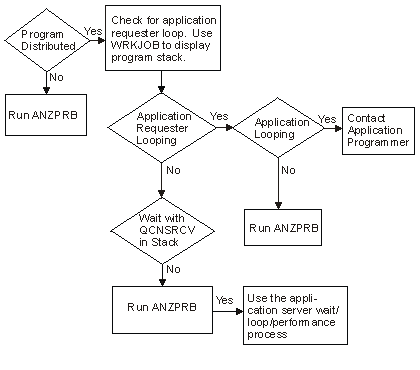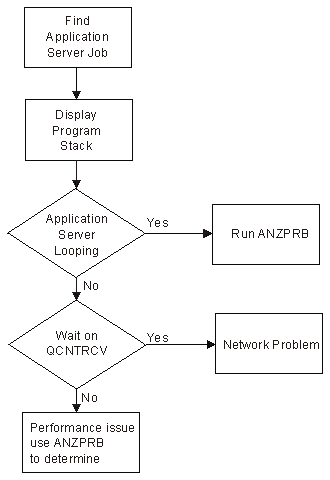If the request takes longer than expected to complete, the first place to check is at the application requester (AR).
Check the job log for message SQL7969, which indicates that a connection to a relational database is complete. This tells you the application is a distributed relational database application. Check the AR for a loop by using the Work with Job (WRKJOB) command to display the program stack, and check the program stack to determine whether the system is looping. If the application itself is looping, contact the application programmer for resolution. If you see QAPDEQUE and QCNSRCV on the stack, the AR is waiting for the application server (AS). If the system is not in a communications wait state, use problem analysis procedures to show whether there is a performance problem or a wait state somewhere else.
You can find the AR job name by looking at the job log on the AS. When you need to check the AS job, use the Work with Job (WRKJOB), Work with Active Jobs (WRKACTJOB), or Work with User Jobs (WRKUSRJOB) command to locate the job on the AS.
From one of these job displays, look at the program stack to see if the AS is looping. If it is looping, use problem analysis to handle the problem. If it is not looping, check the program stack for WAIT with QCNTRCV, which means the AS is waiting for the AR. If both servers are in this communications wait state, there is a problem with your network. If the AS is not in a wait state, there is a performance issue that might have to be addressed.
Two common sources of slow query performance are:
- An accessed table does not have an index. If this is the case, create an index using an appropriate field or fields as the key.
- The rows returned on a query request are not blocked. Whether the rows are blocked can cause a significant difference in query performance. It is important to understand the factors that affect blocking, and tune the application to take advantage of it.
The first time you connect to DB2 Universal Database™ for iSeries™ from a workstation using a product such as DB2® JDBC Universal Driver or DB2 Universal Database™ for Linux®, UNIX® and Windows®, if you have not already created the SQL packages for the product in DB2 UDB for iSeries, the packages will be created automatically, and the NULLID collection might need to be created automatically as well. This will result in a somewhat lengthy delay in getting a response back from the server for one of the first SQL statements issued after the initial connection.
A long delay will occur if the server to which you are trying to connect over TCP/IP is not available. A several minute timeout delay will precede the message A remote host did not respond within the timeout period. An incorrect IP address in the RDB directory will cause this behavior as well.

